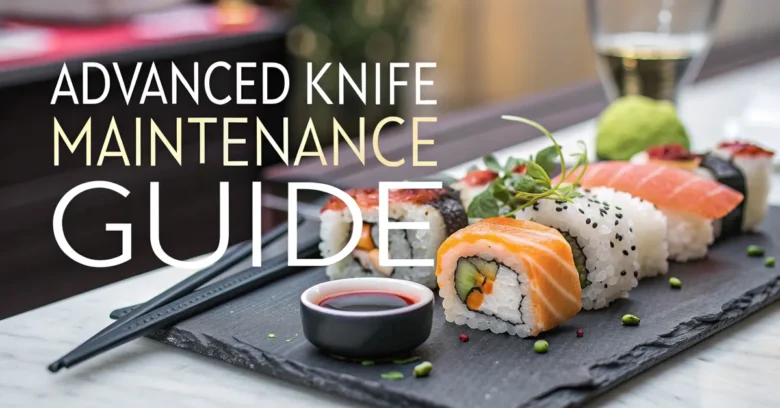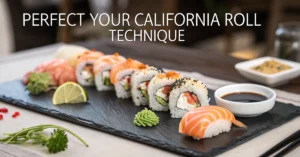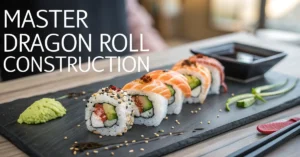Are you a sushi chef in the making? Or just love making sushi at home? A dull knife is the bane of any sushi enthusiast’s existence. It tears the delicate fish, crushes the rice, and generally makes the whole process a frustrating mess. But, with proper knife care, you can keep your blades razor-sharp. The aim? To make perfect sushi every time!
This article isn’t about basic washing and drying. We’re diving deep into the advanced techniques that separate the pros from the amateurs. Think of it as a masterclass in knife care. You’ll learn not just how to maintain your knives, but also how to understand them. By the end, you’ll know the steel, the grind, and the subtle art of keeping your sushi knives in peak condition.
Understanding Your Sushi Knives
Before you even think about sharpening or maintenance, it’s key to know your knives. Different knives call for different care. A delicate deba (a thick, heavy knife for fish preparation) is not the same as a yanagiba (a long, thin slicing knife). Each has its own steel, grind, and purpose.
Types of Sushi Knives
Let’s break down some common sushi knives:
- Yanagiba: This is the sushi knife. Long and slender, it’s for slicing fish with a single, elegant pull. The goal? To maintain the fish’s texture.
- Deba: A sturdy, heavy knife. It’s used for breaking down whole fish. Its thick spine can handle bones and tougher tasks.
- Usuba: A vegetable knife with a thin blade. It’s designed for precise cuts and decorative work.
- Nakiri: Another vegetable knife, rectangular in shape. It allows for clean, straight cuts against a cutting board.
- Santoku: A general-purpose knife. It’s a good all-rounder if you’re not ready to invest in a full set.
Knowing what knives you have is very important before moving on to sharpening.
Steel Types: Carbon vs. Stainless
The steel of your knife plays a big part in knife care. There are two main types to consider:
- Carbon Steel: Known for its sharpness and ease of sharpening. Carbon steel is a top choice for many chefs. But, it’s prone to rust and requires diligent maintenance.
- Stainless Steel: More resistant to rust and corrosion. Stainless steel is easier to care for, but may not hold an edge as well as carbon steel.
Grind: Single Bevel vs. Double Bevel
The grind refers to the angle of the blade. It’s another key factor in how you care for your knives.
- Single Bevel: Most traditional Japanese knives have a single bevel. The blade is ground on one side only. This creates an incredibly sharp edge. It also requires more skill to sharpen.
- Double Bevel: More common in Western knives. The blade is ground on both sides. They’re easier to sharpen and more forgiving to use.
Understanding your knife’s steel and grind is the first step. Next comes the actual maintenance.
Daily Knife Care: Preventing Damage
The best knife care is preventative. A few simple habits can extend the life of your knives. It will keep them sharper for longer.
Cleaning: The Right Way
Never put your sushi knives in the dishwasher. The harsh detergents and banging around will dull the blade. The heat can damage the handle.
- Wash by Hand: Use warm water and a mild soap. Wash the blade gently with a soft sponge.
- Rinse Thoroughly: Make sure to remove all traces of soap.
- Dry Immediately: This is key, especially for carbon steel knives. Use a clean, soft cloth to dry the blade. Pay extra attention to the tang (the part of the blade that extends into the handle).
Proper Storage: Avoiding Scratches and Dings
How you store your knives is crucial.
- Knife Block: A traditional knife block protects the blades. It keeps them from rubbing against each other.
- Magnetic Strip: A magnetic strip displays your knives. It keeps them readily accessible. Just make sure the knives are clean and dry before attaching them.
- Saya (Sheath): A wooden sheath protects the blade. It’s a good option for individual knives.
Cutting Board Selection: Gentle on the Edge
Your cutting board can have a big impact on your knife’s edge.
- Wood: Wood cutting boards are gentle on your knives. Look for hardwoods like maple or walnut. Avoid glass or ceramic cutting boards. They will dull your knives quickly.
- Soft Plastics: Some softer plastic boards are acceptable. But make sure they’re designed for knife use.
Advanced Sharpening Techniques
Sharpening is the most important part of knife care. A sharp knife is safer and more efficient. It gives cleaner cuts. There are two main methods: whetstones and honing rods.
Whetstone Sharpening: The Traditional Method
Whetstones are the traditional way to sharpen Japanese knives. It’s a skill that takes practice. But the results are worth it.
Understanding Grit
Whetstones come in different grits. Grit refers to the size of the abrasive particles.
- Coarse (200-400 grit): Used for repairing damaged blades.
- Medium (800-1200 grit): Used for general sharpening.
- Fine (3000-8000 grit): Used for polishing and refining the edge.
Preparing the Whetstone
- Soak the Stone: Most whetstones need to be soaked in water before use. Follow the manufacturer’s instructions. Some synthetic stones only need a splash of water.
- Stabilize the Stone: Place the stone on a non-slip surface. A wet towel or a stone holder works well.
Sharpening a Double-Bevel Knife
- Find the Angle: Aim for a 15-20 degree angle.
- Apply Pressure: Use light, even pressure. Draw the knife across the stone, from heel to tip.
- Alternate Sides: Sharpen both sides of the blade. Do an equal number of strokes on each side.
- Check the Edge: Use a magnifying glass to inspect the edge. Look for a consistent, sharp line.
Sharpening a Single-Bevel Knife
Sharpening a single-bevel knife is trickier. The goal is to maintain the flat side of the blade.
- Sharpen the Bevel: Focus most of your attention on the beveled side. Use light, even pressure.
- Flatten the Back: Gently flatten the back of the blade. This removes any burr (a small, upturned edge) created during sharpening.
- Alternate Sides: Sharpen the beveled side. Then flatten the back. Repeat until the blade is sharp.
Creating a Burr
As you sharpen, you’ll feel a slight burr forming on the opposite side of the blade. This is a good thing. It means you’re removing metal.
- Remove the Burr: Use light strokes to remove the burr. Alternate sides. Gradually reduce the pressure.
Polishing the Edge
After sharpening, polish the edge with a fine-grit stone. This refines the edge. It makes it even sharper.
Honing Rod: Maintaining the Edge
A honing rod doesn’t sharpen the knife. It realigns the edge. It straightens out any microscopic imperfections.
- Hold the Rod Vertically: Place the tip of the rod on a stable surface.
- Find the Angle: Aim for a 15-20 degree angle.
- Draw the Knife Down: Use light pressure. Draw the knife down the rod. Alternate sides.
- Use a Smooth Motion: The motion should be smooth and consistent.
Advanced Maintenance: Beyond the Basics
Knife care goes beyond daily cleaning and sharpening. There are other steps to take to keep your knives in top condition.
Removing Rust: Gentle Techniques
Rust can be a problem, especially for carbon steel knives.
- Baking Soda Paste: Mix baking soda with water to create a paste. Apply it to the rust. Let it sit for a few minutes. Then, scrub gently with a soft cloth.
- Rust Eraser: A rust eraser is a specialized tool for removing rust. Follow the manufacturer’s instructions.
Handle Care: Preventing Cracks and Splinters
The handle is just as important as the blade.
- Oil the Handle: Wooden handles can dry out and crack. Use a food-grade mineral oil to condition the wood. Apply a small amount of oil to a cloth. Rub it into the handle.
- Avoid Harsh Chemicals: Don’t use harsh chemicals or abrasive cleaners on the handle.
Professional Sharpening: When to Seek Help
Sometimes, your knives need professional attention.
- Damaged Blades: If your knife has a chipped or broken blade, take it to a professional.
- Inconsistent Edges: If you can’t get a consistent edge with your whetstone, seek professional help.
- Rarely Used Knives: Even knives that aren’t used often need to be sharpened. This keeps them in good condition.
Troubleshooting Common Knife Problems
Even with the best knife care, problems can arise. Here are some common issues and how to fix them.
Dull Blades: Causes and Solutions
A dull blade is the most common problem.
- Cause: Improper sharpening, using the wrong cutting board, or cutting hard materials.
- Solution: Sharpen the knife with a whetstone. Use a honing rod to maintain the edge.
Chipped Blades: Repairing Minor Damage
A chipped blade can be frustrating.
- Cause: Cutting bones or hard materials.
- Solution: Use a coarse-grit whetstone to grind down the blade. Create a new edge. This may require professional help.
Bent Blades: Straightening the Steel
A bent blade is a serious problem.
- Cause: Dropping the knife or using it to pry something open.
- Solution: This requires professional repair. Don’t try to straighten the blade yourself.
Rusty Blades: Prevention and Removal
Rust is a common issue with carbon steel knives.
- Cause: Moisture and lack of proper cleaning.
- Solution: Remove the rust with baking soda paste or a rust eraser. Prevent rust by cleaning and drying the knife after each use. Oil the blade regularly.
Investing in Quality Tools
Knife care is easier with the right tools. Invest in quality whetstones, honing rods, and cleaning supplies.
Whetstone Recommendations
- Shapton Glass Stone: Known for its fast cutting and consistent grit.
- King Deluxe Stone: A popular and affordable option.
- Suehiro Cerax Stone: A good all-around stone for both sharpening and polishing.
Honing Rod Recommendations
- F. Dick Sharpening Steel: A classic honing rod with a comfortable handle.
- Wüsthof Sharpening Steel: A high-quality honing rod from a reputable brand.
Cleaning and Maintenance Supplies
- Microfiber Cloths: Soft and absorbent, for cleaning and drying.
- Food-Grade Mineral Oil: For conditioning wooden handles.
- Rust Eraser: For removing rust from carbon steel blades.
Mastering the Art of the Cut
Ultimately, knife care is about more than just maintaining your tools. It’s about mastering the art of the cut. A sharp knife is an extension of your hand. It allows you to create precise, beautiful sushi.
Slicing Fish: The Yanagiba Technique
The yanagiba is designed for slicing fish.
- One Smooth Motion: Use a single, smooth motion. Draw the knife from heel to tip.
- Apply Gentle Pressure: Let the weight of the knife do the work. Don’t force the cut.
- Maintain the Angle: Keep the knife at a consistent angle. This ensures a clean, even slice.
Preparing Vegetables: The Usuba and Nakiri Techniques
The usuba and nakiri are for preparing vegetables.
- Push Cut: Use a push cut. Press the blade down on the vegetable.
- Maintain Contact: Keep the blade in contact with the cutting board. This ensures a clean, straight cut.
- Use a Guide: Use your fingers as a guide. This helps you maintain a consistent thickness.
Presenting Your Sushi: The Final Touch
Presentation is important.
- Clean Cuts: A sharp knife creates clean, beautiful cuts.
- Even Slices: Aim for even slices. This makes the sushi look more appealing.
- Arrange Artistically: Arrange the sushi on a plate. Pay attention to color and texture.
Are Your Blades Worth It?
Taking care of your knives requires you to invest in high-quality equipment. You should use good whetstones, rods, and cleaning supplies. However, the work will give you an edge. You will be able to create beautiful, satisfying sushi.
So, grab your whetstone, hone your skills, and get ready to take your sushi to the next level. With the right knife care, you’ll be amazed at what you can achieve. After all, every sushi chef knows: a sharp knife is the secret ingredient to success.



